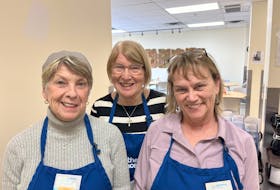Decades after she disappeared, Amelia Earhart still makes headlines, her legacy of gallantry, exploits, and a mysterious fate unalloyed.
Heather Stemp’s Young Adult (YA) series hitches on this, but legitimately so: Earhart had a physical presence in Newfoundland, in Trepassey and at Harbour Grace, where central character Virginia “Ginny” Ross lives, and met her heroine (though not for the first time).
This second book opens in Lafayette, Indiana, in August 1936. Ginny has been accepted to the engineering program at Purdue University, where Earhart is an advisor, an impressive achievement — and sacrifice.
She’ll be away from her family for four years, at a time when all the adults are struggling to find steady work. Ginny had been a steadfast help, with kitchen duties at her Aunt Rose’s hotel, which her brother Billy has promised to step into, but he’s just 12. It took a lot to convince her family, by which we mean her mother, that she could do this.
Now she’s standing on a station platform, the structure empty, no stationmaster, no fellow students, in the kind of heat unbeknownst to Newfoundlanders. Where are the taxis? How is she supposed to get to campus?
Fortunately, another train discharges a new arrival, Mabel Anderson, studying home economics. She explains that the taxis will come as more students assemble, there’s also a trolley riding to Perdue, and everything is quiet because it’s Sunday morning.
After six days’ travel, Ginny had lost track. Together they convey their luggage to the Women’s Residence, where they’re assigned as roommates.
In the dining hall, which serves three meals and afternoon tea, they are soon chatting with other students, who all appear quite glamourous to Gunny. “Back upstairs the girls in our hallway went from room to room admiring the clothes the others had brought. I sat on my bed and greeted them but I couldn’t understand half of what they said about hems and collars. To me a dress was green or blue, short or long. I’d never heard of ‘cut on the bias’ or ‘hand smocked.’”
She’s never worn lipstick and, at 16, is two years younger than the other freshmen.
She also hears rumours about one of her instructors, Prof, Malcolm Jones. He’s Mabel’s uncle, and she insists he is kind, in fact that he’s paying for her university education. But there are undertones suggesting his discomfort with women in non-traditional fields. And that’s before Ginny reveals she’s studying engineering as a step towards becoming a pilot.
There are books to be collected, schedules to confirm, and clubs to join. Ginny finds an engineering club based on scholarship, as opposed to ability and personality: “They’ll reject me because I’m a girl and then claim it was because of my personality.”
The University Airport, with the Lockheed Vega and the Taylor Cub, is where she feels most comfortable. She quickly establishes her skill with engines. But that confidence ebbs when she approaches an actual classroom.
“Male students turned to look at me but no one said a word. They nudged each other and snickered instead. I kept my eyes down and walked through the front door. I had planned to walk up the stairs with my head held high.”
When class starts, things get no better.
“My heart pounded in my ears. The voices in the room faded into the background. I took deep breaths and tried to figure out what had just happened. One minute Professor Jones was smiling at me. The next minute I was sitting at the back of the room and everyone was laughing at me.”
The university has committed to furthering young women’s education. But the environment lags behind that ideal.
How to keep a low profile, when she knows the material so fluently? When, in fact, she knows Amelia Earhart? And will Mabel be ostracized because of their friendship?
“I felt like I was leading a double life and I didn’t know what to do about it.”
She finds allies, at school and at the Airport. She rallies to prove her scholastic worth.
“No hands went up. I raised mine but instead of calling on me, Professor Jones gave the answer himself. The next time I raised my hand, I waved it so everyone could see. Again, Professor Jones gave the answer. I decided to try one more time. When no one else put up his hand, I waved mine even harder.
‘Are there flies back there, Miss Ross?’
I lowered my hand. ‘No, sir.’
‘Then kindly stop waving.’
The boys snickered.
‘But I know the answer.’
‘You will know the answer when I call on you.’
“So much for showing him what I know. As soon as the class was over, I left. Apparently, it was back to the drawing board for plan number three.”
The novel is clear-eyed, nicely cast, and authentic, with details like Earhart’s actual role with Purdue neatly incorporated (let alone I bet you could actually learn a thing or two about small-engine repair), and leaves readers poised for a third installment.
Joan Sullivan is editor of Newfoundland Quarterly magazine. She reviews both fiction and non-fiction for The Telegram.









